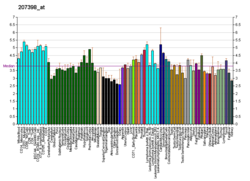HOXD13
| HOXD13 | |||||||||||||||||||||||||||||||||||||||||||||||||||
|---|---|---|---|---|---|---|---|---|---|---|---|---|---|---|---|---|---|---|---|---|---|---|---|---|---|---|---|---|---|---|---|---|---|---|---|---|---|---|---|---|---|---|---|---|---|---|---|---|---|---|---|
| Identificadores | |||||||||||||||||||||||||||||||||||||||||||||||||||
| Nomes alternativos | HOXD13 | ||||||||||||||||||||||||||||||||||||||||||||||||||
| IDs externos | OMIM: 142989 HomoloGene: 20147 GeneCards: HOXD13 | ||||||||||||||||||||||||||||||||||||||||||||||||||
| Doenças Geneticamente Relacionadas | |||||||||||||||||||||||||||||||||||||||||||||||||||
| brachydactyly-syndactyly syndrome, brachydactyly type E1, Associação VACTERL, sindactilia[1] | |||||||||||||||||||||||||||||||||||||||||||||||||||
| |||||||||||||||||||||||||||||||||||||||||||||||||||
| |||||||||||||||||||||||||||||||||||||||||||||||||||
| |||||||||||||||||||||||||||||||||||||||||||||||||||
| Wikidata | |||||||||||||||||||||||||||||||||||||||||||||||||||
| |||||||||||||||||||||||||||||||||||||||||||||||||||
A proteína homeobox Hox-D13 é uma proteína que em humanos é codificada pelo gene HOXD13. Este gene pertence à família dos genes homeobox.[3][4][5] Os genes homeobox codificam uma família altamente conservada de fatores de transcrição que desempenham um papel importante na morfogênese em todos os organismos multicelulares.[6]
Veja também
- Homeobox
Referências
- ↑ «Doenças geneticamente associadas a HOXD13 ver/editar referências no wikidata»
- ↑ «Human PubMed Reference:»
- ↑ Acampora D, D'Esposito M, Faiella A, Pannese M, Migliaccio E, Morelli F, et al. (dezembro de 1989). «The human HOX gene family». Nucleic Acids Research. 17 (24): 10385–402. PMC 335308
 . PMID 2574852. doi:10.1093/nar/17.24.10385
. PMID 2574852. doi:10.1093/nar/17.24.10385 - ↑ McAlpine PJ, Shows TB (julho de 1990). «Nomenclature for human homeobox genes». Genomics. 7 (3). 460 páginas. PMID 1973146. doi:10.1016/0888-7543(90)90186-X
- ↑ «Entrez Gene: HOXD13 homeobox D13»
- ↑ Davis AP, Capecchi MR (abril de 1996). «A mutational analysis of the 5' HoxD genes: dissection of genetic interactions during limb development in the mouse». Development. 122 (4): 1175–85. PMID 8620844
Leitura adicional
- Johnson RL, Tabin CJ (setembro de 1997). «Molecular models for vertebrate limb development». Cell. 90 (6): 979–90. PMID 9323126. doi:10.1016/S0092-8674(00)80364-5
- Goodman FR (outubro de 2002). «Limb malformations and the human HOX genes». American Journal of Medical Genetics. 112 (3): 256–65. PMID 12357469. doi:10.1002/ajmg.10776
- Scott MP (novembro de 1992). «Vertebrate homeobox gene nomenclature». Cell. 71 (4): 551–3. PMID 1358459. doi:10.1016/0092-8674(92)90588-4
- D'Esposito M, Morelli F, Acampora D, Migliaccio E, Simeone A, Boncinelli E (maio de 1991). «EVX2, a human homeobox gene homologous to the even-skipped segmentation gene, is localized at the 5' end of HOX4 locus on chromosome 2». Genomics. 10 (1): 43–50. PMID 1675198. doi:10.1016/0888-7543(91)90482-T
- Sarfarazi M, Akarsu AN, Sayli BS (agosto de 1995). «Localization of the syndactyly type II (synpolydactyly) locus to 2q31 region and identification of tight linkage to HOXD8 intragenic marker». Human Molecular Genetics. 4 (8): 1453–8. PMID 7581388. doi:10.1093/hmg/4.8.1453
- Muragaki Y, Mundlos S, Upton J, Olsen BR (abril de 1996). «Altered growth and branching patterns in synpolydactyly caused by mutations in HOXD13». Science. 272 (5261): 548–51. Bibcode:1996Sci...272..548M. PMID 8614804. doi:10.1126/science.272.5261.548
- Akarsu AN, Stoilov I, Yilmaz E, Sayli BS, Sarfarazi M (julho de 1996). «Genomic structure of HOXD13 gene: a nine polyalanine duplication causes synpolydactyly in two unrelated families». Human Molecular Genetics. 5 (7): 945–52. PMID 8817328. doi:10.1093/hmg/5.7.945
- Warren ST (janeiro de 1997). «Polyalanine expansion in synpolydactyly might result from unequal crossing-over of HOXD13». Science. 275 (5298): 408–9. PMID 9005557. doi:10.1126/science.275.5298.408
- Goodman FR, Mundlos S, Muragaki Y, Donnai D, Giovannucci-Uzielli ML, Lapi E, et al. (julho de 1997). «Synpolydactyly phenotypes correlate with size of expansions in HOXD13 polyalanine tract». Proceedings of the National Academy of Sciences of the United States of America. 94 (14): 7458–63. Bibcode:1997PNAS...94.7458G. PMC 23843
 . PMID 9207113. doi:10.1073/pnas.94.14.7458
. PMID 9207113. doi:10.1073/pnas.94.14.7458 - Goodman F, Giovannucci-Uzielli ML, Hall C, Reardon W, Winter R, Scambler P (outubro de 1998). «Deletions in HOXD13 segregate with an identical, novel foot malformation in two unrelated families». American Journal of Human Genetics. 63 (4): 992–1000. PMC 1377502
 . PMID 9758628. doi:10.1086/302070
. PMID 9758628. doi:10.1086/302070 - Limongi MZ, Pelliccia F, Gaddini L, Rocchi A (2000). «Clustering of two fragile sites and seven homeobox genes in human chromosome region 2q31-->q32.1». Cytogenetics and Cell Genetics. 90 (1–2): 151–3. PMID 11060466. doi:10.1159/000015651
- Harrington JJ, Sherf B, Rundlett S, Jackson PD, Perry R, Cain S, et al. (maio de 2001). «Creation of genome-wide protein expression libraries using random activation of gene expression». Nature Biotechnology. 19 (5): 440–5. PMID 11329013. doi:10.1038/88107
- Goodman FR, Majewski F, Collins AL, Scambler PJ (fevereiro de 2002). «A 117-kb microdeletion removing HOXD9-HOXD13 and EVX2 causes synpolydactyly». American Journal of Human Genetics. 70 (2): 547–55. PMC 384929
 . PMID 11778160. doi:10.1086/338921
. PMID 11778160. doi:10.1086/338921 - Kosaki K, Kosaki R, Suzuki T, Yoshihashi H, Takahashi T, Sasaki K, et al. (fevereiro de 2002). «Complete mutation analysis panel of the 39 human HOX genes». Teratology. 65 (2): 50–62. PMID 11857506. doi:10.1002/tera.10009
- Debeer P, Bacchelli C, Scambler PJ, De Smet L, Fryns JP, Goodman FR (novembro de 2002). «Severe digital abnormalities in a patient heterozygous for both a novel missense mutation in HOXD13 and a polyalanine tract expansion in HOXA13». Journal of Medical Genetics. 39 (11): 852–6. PMC 1735011
 . PMID 12414828. doi:10.1136/jmg.39.11.852
. PMID 12414828. doi:10.1136/jmg.39.11.852 - Caronia G, Goodman FR, McKeown CM, Scambler PJ, Zappavigna V (abril de 2003). «An I47L substitution in the HOXD13 homeodomain causes a novel human limb malformation by producing a selective loss of function». Development. 130 (8): 1701–12. PMID 12620993. doi:10.1242/dev.00396
 Portal da genética
Portal da genética Portal da bioquímica
Portal da bioquímica















